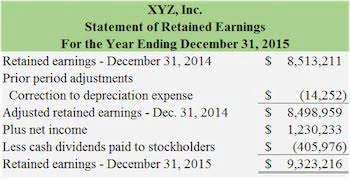- May 23, 2025
- Posted by: admin
- Category: Bookkeeping

For the past 52 years, Harold Averkamp (CPA, MBA) hasworked as an accounting supervisor, manager, consultant, Accounting for Churches university instructor, and innovator in teaching accounting online. The accounting term that means an entry will be made on the left side of an account. A balance on the right side (credit side) of an account in the general ledger.
- Short-term investments are temporary investments that do not qualify as cash equivalents but are expected to turn to cash within one year.
- Since treasury stock is not currently owned by stockholders, it should not be included as part of their worth.
- Basically, any income a firm gets that is not counted as part of the Income Statement is counted as “Other Comprehensive Income”.
- On May 1, when the dividends are paid, the following journal entry is recorded.
- For example, a company will have a Cash account in which every transaction involving cash is recorded.
- The record date merely determines the names of the stockholders that will receive the dividends.
- If stockholders want to sell their stock, they must find a buyer usually through the services of a stockbroker or an online app.
What Is a Good Shareholders’ Equity Number?

Retained earnings are corporate income or profit that is not paid out as dividends. The formula for a statement of changes in equity includes the opening and closing value of the equity, net income for the year, dividends paid, and other changes. But when reported in a financial statement, it is classified as issued stock rather than outstanding. In this article, you will get to understand the components of stockholder’s equity in the balance sheet, its calculation, and how it relates to the financial stability of the company.

Large Negative Adjustment to Shareholders Equity on my 1120S – Should I be concerned?
The combination of the last two bullet points is the amount of the company’s net income. Instead, each year the recorded cost of the goodwill must be tested to see if the cost must be reduced by what is known as an impairment https://sellinghomegalicia.com/ask-a-mofo-common-provisions-in-venture-capital/ loss. An asset’s cost minus its accumulated depreciation is known as the asset’s book value or carrying value. Another example of other receivables is a corporation’s income tax refund related to its recently filed income tax return. The balance in the general ledger account Allowance for Doubtful Accounts is an estimate of the amount in Accounts Receivable that the company anticipates will not be collected.

BAR CPA Practice Questions: The MD&A and Notes for Government Financial Statements
Owner’s equity and retained earnings are largely synonymous in many circumstances, but there are key differences in exactly how they’re calculated. Many small businesses with just a few owners will prefer to use owner’s equity. Retained earnings are more useful for analyzing the financial strength of a corporation. The earnings of a corporation are kept or retained and are not paid out directly to the owners. In contrast, earnings are immediately available to the business owner in a sole proprietorship unless the owner elects to keep the money in the business.

For example, a partnership of two people might split the ownership 50/50 or in other percentages as stated in the partnership agreement. Our accounting firm is a professional service firm that focuses on providing expert advice in accounting and tax. They are able to provide our clients with the most accurate and reliable solutions for their particular financial/accounting needs. The Balance sheet is essential to a company in various ways such as the following; it helps in giving a comprehensive list of the company’s earnings from all its sources. Use Wafeq to manage all your accounting transactions and run your business better. For example, say Wasslak strikes a deal that the customer will pay SAR 600 upfront in exchange for the delivery of 30 packages each month for six months.
- Any change in the Common Stock, Retained Earnings, or Dividends accounts affects total stockholders’ equity, and those changes are shown on the statement of stockholder’s equity.
- A startup business typically experiences a decline in its stockholders’ equity until its products become profitable, after which the inflow of profits boosts its retained earnings balance.
- Information relating to authorized shares, par value, outstanding shares, and issued issues must need to be disclosed for each type of stock displayed.
- Jean earned her MBA in small business/entrepreneurship from Cleveland State University and a Ph.D. in administration/management from Walden University.
- If the net realizable value of the inventory is less than the actual cost of the inventory, it is often necessary to reduce the inventory amount.
- A corporation’s accounting records are involved in stock transactions only when the corporation is the issuer, seller, or buyer of its own stock.
- For example, if a corporation initially sells 2,000 shares of its stock to investors, and if the corporation did not reacquire any of this stock, this corporation is said to have 2,000 shares of stock outstanding.
- Our editorial team independently evaluates and recommends products and services based on their research and expertise.
- It highlights how external economic factors, beyond a company’s immediate control, can influence its financial position.
- Shareholders’ equity, as noted, is the total amount that a company could repay shareholders in the event of liquidation.
- Inventory includes amounts for raw materials, work-in-progress goods, and finished goods.
(The depreciation journal entry includes a debit to Depreciation Expense and a credit to Accumulated Depreciation, a contra asset account). The purpose is to allocate the cost to expense in order to comply with the matching principle. In other words, the amount allocated to expense is not indicative of the economic value being consumed. Similarly, the amount not yet allocated is not an indication of its current market value. It is important to realize that the amount of retained earnings will not be in the corporation’s bank accounts. The reason is that corporations will likely use the what goes into stockholders equity cash generated from its earnings to purchase productive assets, reduce debt, purchase shares of its common stock from existing stockholders, etc.
